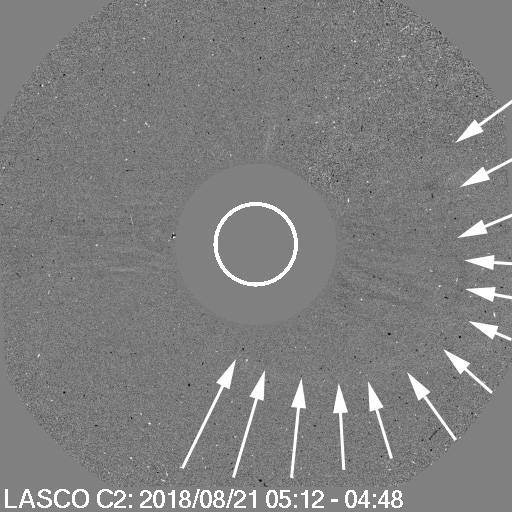What's the buzz about? CME aimed towards Earth?
Wednesday, 22 August 2018 15:58 UTC

A buzz started to develop in the space weather community about a possible earth-directed coronal mass ejection. We took a look at the event and weren't impressed but considering it is solar minimum and there hasn't been much to get excited about, we do a short analysis anyway.
A very faint coronal mass ejection became visible on SOHO/LASCO coronagraph imagery early on 21 August from what likely was a minor filament eruption. On difference imagery and a pair of eyes that rival those of a hawk, you can see a partial halo coronal mass ejection launched southwest of the Sun-Earth line. We made this image with a ridiculous amount of arrows indicating the faint partial halo outline. You are watching a difference image from the LASCO C2 instrument on the SOHO space craft.

Image: Difference image from the LASCO C2 instrument on the SOHO space craft showing a very faint partial halo coronal mass ejection.
We understand the frustration, it is almost solar minimum and space weather is dull apart from an occasional coronal hole stream but coronal mass ejection like these are normally not even worth mentioning for us. Not only is the plasma cloud probably going to miss Earth (partial halo coronal mass ejection that spans little over 120 degrees) it hardly has any density to it (very faint) and it is also very slow at about 300 to 350 km/s.
In the unlikely case that this coronal mass ejection arrives at Earth which could be somewhere on August 25, the impact is expected to be negligible. Coronal hole solar wind streams are much more reliable and interesting to keep an eye on than these wimpy coronal mass ejections. This may sound very pessimistic but we are honest here and say things how they are and we hope our audience appreciates that.
By the way, this post is riddled with technical terms which some of you might not understand. We understand that and while we try to keep such posts to a minimum we have to make posts like this sometimes to motivate our claims. If you'd like help to understand certain terms than by all means leave a comment with any questions you might have! We are happy to answer them! SpaceWeatherLive is a website for advanced space weather enthusiasts but our main goal is that every single visitor learns about space weather and develops a good understanding of the subject.
Thank you for reading this article! Did you have any trouble with the technical terms used in this article? Our help section is the place to be where you can find in-depth articles, a FAQ and a list with common abbreviations. Still puzzled? Just post on our forum where we will help you the best we can!
Latest news
Latest forum messages
More topicsSupport SpaceWeatherLive.com!
A lot of people come to SpaceWeatherLive to follow the Sun's activity or if there is aurora to be seen, but with more traffic comes higher server costs. Consider a donation if you enjoy SpaceWeatherLive so we can keep the website online!

Space weather facts
| Last X-flare | 2025/03/28 | X1.1 |
| Last M-flare | 2025/04/01 | M2.4 |
| Last geomagnetic storm | 2025/03/27 | Kp5 (G1) |
| Spotless days | |
|---|---|
| Last spotless day | 2022/06/08 |
| Monthly mean Sunspot Number | |
|---|---|
| February 2025 | 154.6 +17.6 |
| April 2025 | 147 -7.6 |
| Last 30 days | 128.8 -21.8 |


